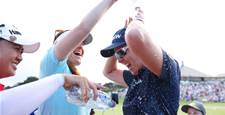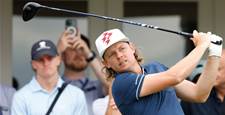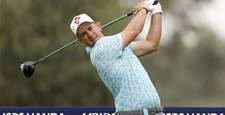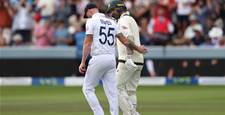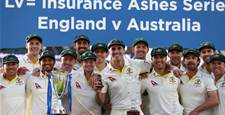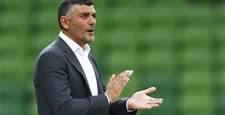With a sporting pedigree like hers, it was natural that Alana Boyd would be steered towards track and field – her mother, Denise Boyd (nee Robertson), was our champion sprinter back in the late ’70s/early ’80s, and her father, Ray Boyd, was our champion pole vaulter in the same era.
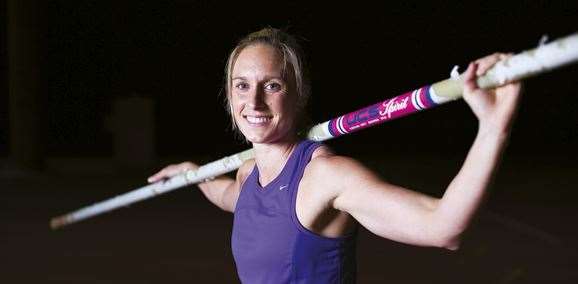
With a sporting pedigree like hers, it was natural that Alana Boyd would be steered towards track and field – her mother, Denise Boyd (nee Robertson), was our champion sprinter back in the late ’70s/early ’80s, and her father, Ray Boyd, was our champion pole vaulter in the same era. But then, there’s not much that is “natural” about the sport of pole vaulting. While our men’s champ, Steve Hooker, has recently raised the sport’s profile with his Olympic gold in Beijing, Boyd has consistently been our best-performed woman. She has represented Australia at the last two Olympics, and took out the gold medal at the 2010 Comm Games in Delhi. She looked on track to really make a name for herself heading into the London Olympics last year, 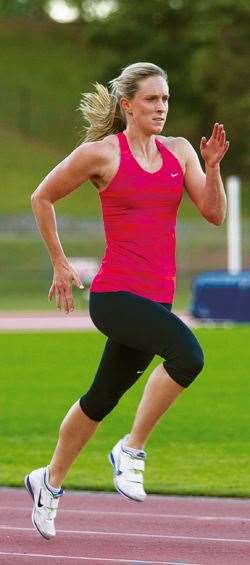 after smoking the Australian record during our domestic season in the lead-up. But circumstances conspired against her there, and she finished a disappointing (for her) 11th. That led to a change of coaches – leaving the Perth pole vault hothouse headed by coach Alex Parnov and returning earlier this year to her home in Brisbane, to resume being coached by father Ray. It’s a partnership that’s already seen her qualify for next month’s World Championships in Moscow (Aug 10-18), with her sights firmly set on Rio in 2016.
after smoking the Australian record during our domestic season in the lead-up. But circumstances conspired against her there, and she finished a disappointing (for her) 11th. That led to a change of coaches – leaving the Perth pole vault hothouse headed by coach Alex Parnov and returning earlier this year to her home in Brisbane, to resume being coached by father Ray. It’s a partnership that’s already seen her qualify for next month’s World Championships in Moscow (Aug 10-18), with her sights firmly set on Rio in 2016.
With an HR business degree behind her, this 29-year-old works part-time for her very understanding employers at John Holland, who even allowed her a break from work to share with Inside Sport a few of the secrets of her vaulting success before she headed off to Europe for Diamond League competitions leading up to Moscow.
KEEPING ON
“I didn’t jump my best in London. I cleared 4.55 to make the final, which I was very happy with because it was a tough qualifying; they had the pole vault set up into a significant headwind. The British girl landed back on the track and broke her wrist and the Russian landed in the box and broke her ankle, which kind of indicated how difficult and dangerous the conditions were for us. And in the final, again, they didn’t turn the pole vault around. Which is really what they should’ve done, but their hands were tied. Unfortunately we copped it.
“But I guess you go out there with the same conditions as the other 11 girls – you just have to get on with it. In the final I was disappointed with my jump. It didn’t reflect where I came from in the domestic season. I’d been jumping consistently over 4.60, and had cleared the 4.76 for the Australian record, so I was on an absolute high [this height would’ve won gold in London]. I feel that maybe Alex [Parnov] and I didn’t get the preparation exactly right. There were a few technical things we were trying to nut out, but I felt like my running and speed side of things were a little bit neglected; I just felt like I wasn’t in a great position at the take-off because I lacked speed.
To finish 11th was disappointing. I still feel like it was a missed opportunity – medals were up for grabs that day.”
THE SUNNY SIDE
“All I can do now is say, ‘Right, where can we cross those Ts and dot those Is and make sure everything that didn’t go right last time can work next time?’ So I came back home from WA earlier this year. I’d moved over there to train with Alex in 2009. It was initially a three-year plan leading into London, so it was time to reassess what I wanted to do. After London, I was a little unsure ... I decided late last year that it was in my best interests to come home.
“As you get older you’re a bit more in tune with your body and what works for you and what doesn’t – I’ve been pole vaulting now for 11 years and I know my event and I know what’s a good jump. I know now what works for me and what areas I can tweak to make things better.”
HOME SWEET HOME
“It’s really nice to be home and have Dad as my coach again. He lives on the Sunshine Coast and I live in Brisbane – I travel up there a couple of times a week for my pole vault sessions. It’s the best of both worlds: that’s where I grew up and I still have a lot of friends and family up there, which is a big thing for me. I love catching up for dinner – though most of the time I’m the designated driver; I’ve either got training in the morning or competition coming up. But I still try to have that social life – I’m 29 years old and trying to keep my life as normal as possible in amongst my training.”
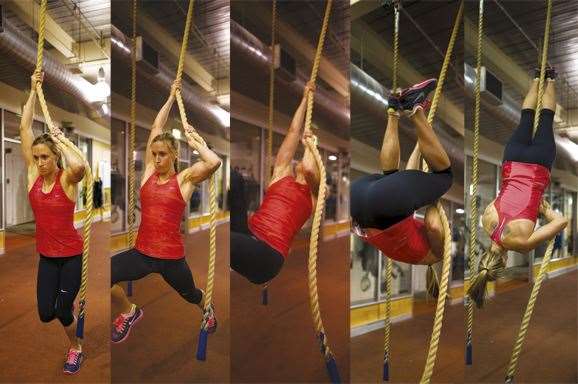
PARENTAL GUIDANCE
“Dad and I are very much on the same page now with training and the things that we both think I need to do better to jump higher. Being my father, he has my best interests at heart and I have complete trust and faith in him, but that doesn’t come without its difficulties. I guess I sometimes say things to my coach that I shouldn’t because he’s my father [laughs]. You get frustrated and it’s easier to release those frustrations on him – poor old Dad.”
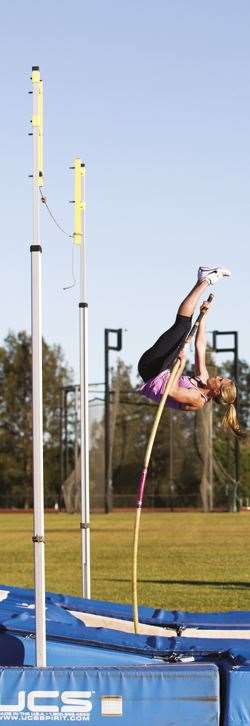 BEGINNINGS
BEGINNINGS
“I’d competed in high jump in primary school and hurdles and sprints all through high school. Then before the 2000 Sydney Games they built an athletics track nearby at the Uni for athletes coming out for the Games. And with the track came the pole vault pit. Dad was out there training one day and said to my brother and sister and me, ‘How would you like to have a swing on a pole?’ My sister wasn’t interested, but my brother and I were keen; I’d done gymnastics when I was younger so I had that body awareness and was used to being upside-down. I took to it quite well. I was 18 at the time.
“I always had the goal of wanting to compete at an Olympic Games. From when I was six, it was, ‘Mum and Dad competed at the Olympics and I want to, too.’ I had figured out you have to have that pure speed to be world-class in the hurdles. And I didn’t have it. And, I dunno, I just liked pole vaulting from the start. Dad had never coached anyone before, so he was learning with us. It was like being thrown into the deep end.
“Since then he’s spent a lot of time with other coaches around the country, and just stood with them at pole vault competitions and picked their brains and watched a lot of footage. Obviously he coached me to an Olympic Games in 2008. Now I’m back with him and he’s coached me to a world championships this year and hopefully another Olympics in Rio in 2016.”
POWER
“My Dad will be the first to admit that his area of expertise is not in the gym – he was a pole vaulter back in the ’70s and ’80s, and doesn’t have a big knowledge base of strength and conditioning. So I’m working with Kieran Young, who is the strength and conditioning coach at the Queensland Academy of Sport.
“I’ve become stronger in the gym. I have a bit of a shoulder problem that’s developed over time that I’ll have to manage for the rest of my career. So I do a lot of rehab-based exercises, with regular physio and massage to make sure I’m giving myself every chance to manage the shoulder.
“I have a bit of a subscap [subscapularis] tendon issue going on – damage to the tendon. }And I also have an impingement, which is the main thing; I’ve done a lot of work to open up the shoulder. It’s my top hand: when I put my arm above my head to plant the pole, that’s when it hurts. But it’s a common injury. At the moment it’s a little bit cranky, but it isn’t all the time – though it’s never pain-free. So a few of my exercises in the gym are modified and obviously the importance is placed on my pole vault session because they’re the technical sessions I need to do right now.
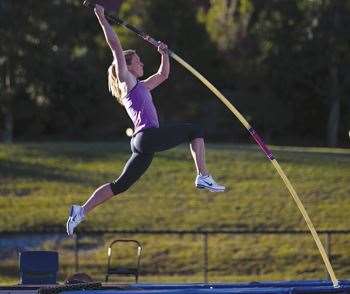
“My Mum also has an input into my running program. She coaches a squad of athletes, and she’s at pretty much all of my pole vault sessions; her job is basically to take video of me. We watch it back on a TV out at the track. So it’s a bit of a team effort.
“They’re at the University of the Sunshine Coast, which is at Sippy Downs. We have a pole vault platform there. It’s something I started doing in Perth after I had an operation on my knee in early 2011. It takes the stress off the body. You can do more jumps in training – for example,
I run off four steps on the platform and I can jump on the poles that I use off a full run-up of 16 steps. So it gives you the feeling of holding a big pole and clearing 4.50, but off a four-step run-up. It allows you to do more jumps and work on the technical aspects. Then you pull the platform aside and you can work on the run-up and the approach and the plants on the flat.
“I usually do two gym sessions a week, two track sessions, and two weights sessions. And then anywhere from two to four pole vault sessions.
In two of my pole vault sessions I do the bulk of the jumps on the flat. The other two pole vault sessions are normally just off the platform – maybe 15 to 20 jumps of two, three or four steps, purely technique-based.”
STRETCHING
“In my warm-ups I tend to do more ballistic stretching – not holding positions for long, and more actual run-throughs rather
than actually stretching the muscles. But full stretching post-session is important for recovery and to make sure I maintain flexibility.”
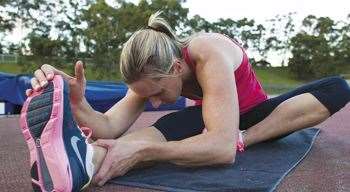 ROPE CLIMBING
ROPE CLIMBING
“The rope is a pretty standard exercise. It gives the feeling of whipping yourself upside-down. It’s something I did a lot more early on, but because we have the platform now, I get the same feeling that way.”
CHIN UPS
“I do chin ups with weights, depending on what time of season it is: the number of reps will differ and the weight will differ. I might be doing five reps of five starting with 10kg and progressing up to 17kg, and then the reps will drop and I might do three reps of three and they’ll be heavier weights and that type of thing. Or I’ll do more reps and I’ll just do body weight. It just depends on the time of season. It’s such a good upper-body exercise.”
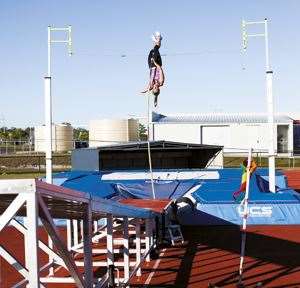 LEGWORK
LEGWORK
“I’ll do a step up where I’m working with a heavier weight and it’s slower and controlled. Then at different times it’ll be a lighter weight and it’ll be a more dynamic movement, faster. Again, it depends on the time of season. I never want to be too slow and heavy in the gym because I still have to stay very dynamic for my sport.”
CRUNCH TIME
“Touch wood I haven’t had any bad falls. I’ve broken a pole once. It broke mid-bend and I landed in the pit on my shoulders and neck. It was a weird sensation: you’ve got this pressure on the pole and you’re about to go upside-down, but all of a sudden you’re just falling instead. I was a bit shaky after it happened, so I had a bit of a break for 15 or 20 minutes. But then I picked up another pole and jumped straight away. You can’t have that as your last memory from a session.”
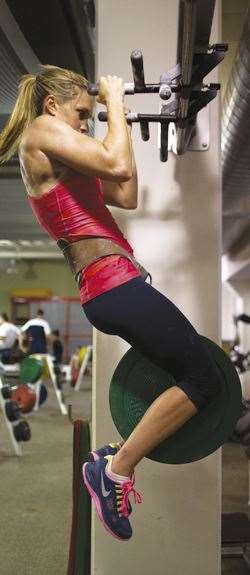 NERVE
NERVE
“Yes, I have faced the loss of nerve. Not as a result of a fall or anything, but just ... I guess the event isn’t a natural thing to do. It’s not normal to take off three and half metres out of the box and go upside-down on a pole ... [laughs] And sometimes you just go through stages where you’re not entirely confident. And it’s really hard to stand on the end of a runway and fake it. So yeah, for me to go back to a short approach and the platform is beneficial to me, because it’s a bit of a safety net. You can go, ‘Well, I’m already halfway there.’
In times like that, Dad will suggest I go back to softer poles so that you have no issues about getting through to the pit. And you just gain that confidence.
“You have a love/hate relationship with the poles – sometimes you’re on and sometimes you’re not. It’s those times when you’re not on that
you have to train yourself to trust yourself and know that you’ve done it thousands and thousands of times before.”
TAKE-OFF
“I guess the secret is to not think about clearing the bar, and that’s easier said than done. You actually think about the process of doing it correctly. I don’t have a set routine, but I have a couple of cues that I say to myself to get things right. And I talk to my coach between jumps to see if there’s something he specifically sees that I’m doing or not doing well. And so that’s what’s in the forefront of my mind. But for me it’s the importance of just relaxing and not pushing too hard from the first step. When I do that well, it sets up the jump way better for me.
Related Articles

Viva Las Vegas: Join Golf Australia magazine's Matt Cleary on a golf and rugby league spectacular
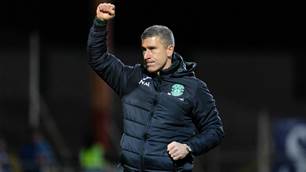
Champion A-League coach set to join Premier League giants


